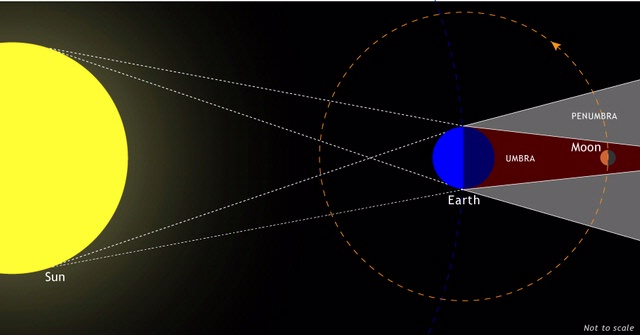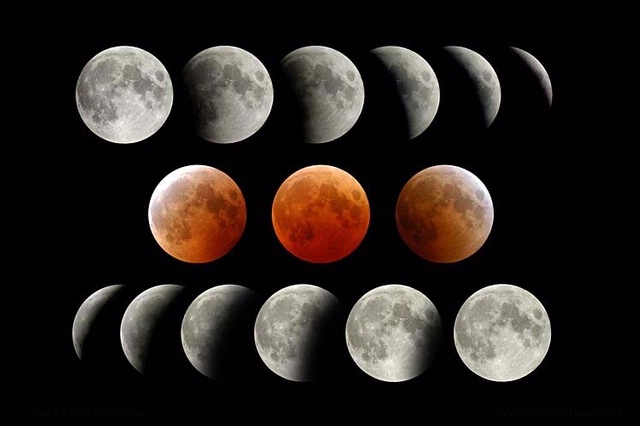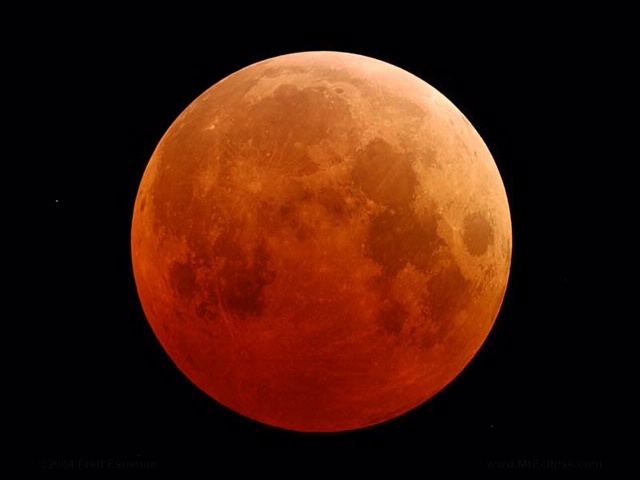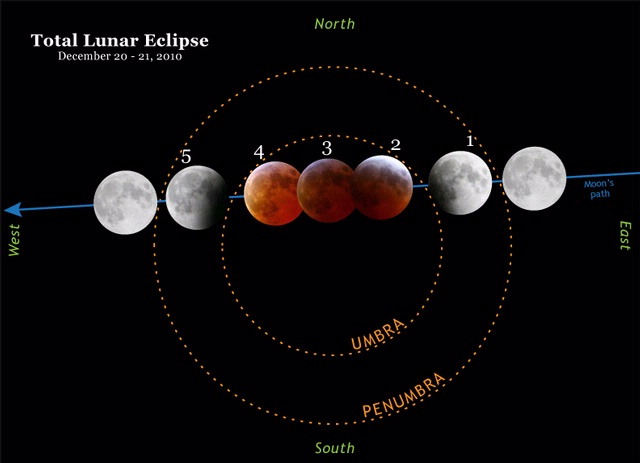The Moon is one of the most easily recognized celestial objects and arguably the easiest one to observe. It is simple to view the changing phases from day to day, with your naked eyes. Binoculars or a telescope will reveal countless craters, ancient lava flows, and other intriguing lunar features. Of the handful of thrilling astronomical events a person can witness in their lifetime, such as meteor showers, planetary transits and oppositions and auroras, solar and lunar eclipses are a must-see.
During the waning hours of December 20th and into the early hours of December 21st, people in North America will have the chance to witness a total lunar eclipse. A total lunar eclipse occurs when the Sun, Earth, and Moon are precisely aligned and the Moon passes into the shadow of the Earth. In other words, the Earth is preventing sunlight from reaching the Moon. Although an eclipsed Moon is always full, a lunar eclipse will not occur every time there is a full Moon since the Moon’s orbit is slightly tilted compared to the plane in which Earth orbits the Sun. When the Moon reaches one of the two points in its orbit where it lines up exactly with the Sun and the Earth, either a solar or lunar eclipse will occur.
eclipse diagram
This shows the geometry of a lunar eclipse. When the Sun, Earth, and Moon, are precisely aligned, a lunar eclipse will occur. During an eclipse the Earth blocks sunlight from reaching the Moon. Earth creates two shadows: the outer, pale shadow called the penumbra, and the dark, inner shadow called the umbra. The eclipse is noticeable once the Moon enters the umbra.
A lunar eclipse is much easier to observe than a solar eclipse. To view a solar eclipse, one has to travel to a very specific location on Earth. For a lunar eclipse, anyone located on the night side of the Earth has the opportunity to observe it. North America will have the best seat in the house for this total lunar eclipse. Provided they have clear skies, viewers should be able to see the entire eclipse from start to finish. Observers in East Asia, Australia, and New Zealand will see the Moon rising during the eclipse while those in Europe, West Africa, and South America will see the Moon set during the eclipse.
To watch a lunar eclipse you don’t need to use a telescope or any special equipment; simply go outside and enjoy the view. The duration of this total lunar eclipse is approximately four and half hours. If you don’t want to be extremely tired at work or school on Tuesday by staying up for the entire event, you can still see different stages of the eclipse in just over an hours’ time. On the east coast of the United States, the lunar eclipse officially begins around 1 am on the morning of December 21st. However, the exciting part of the eclipse won’t begin until a half hour later.
eclipse sequence
This is a sequence of images taken and arranged by amateur astronomer, Fred Espenak. During a total lunar eclipse, viewers will see the shadow of the Earth slowly move across the surface of the Moon, covering it. Totality occurs when the Moon is fully covered. After totality, the Moon slowly moves out of Earth's shadow. Courtesy of Fred Espenak.
A total lunar eclipse begins when the Moon enters the pale, outer portion of the Earth’s shadow, known as the penumbra. This causes a very subtle darkening of the Moon which is almost undetectable. The umbra is Earth’s dark, inner shadow where no direct sunlight reaches. When the Moon moves into the umbra, the partial eclipse begins, and you will begin to see a dark, curved shadow creep across the lunar surface. Partial eclipse begins at 1:33 a.m. on December 21st for east coast viewers. Totality begins at 2:41 a.m. EST when the umbra has completely engulfed the Moon.
totality
During totality, the Moon is still visible. Sunlight passing through Earth's atmosphere projects itself onto the lunar surface and casts it in an orange or reddish glow. Courtesy of Fred Espenak.
Despite not receiving any direct sunlight, the Moon will still be visible during totality, cast in an orange or reddish glow. This is due to scattered sunlight passing through Earth’s atmosphere and projecting onto the Moon. You have most likely seen this type of scattering of sunlight during brilliantly colored sunrises and sunsets. The color of the Moon during totality will depend on the clarity of the atmosphere during the time of the eclipse. If it’s clear, the Moon will have an orange tint. However, if there’s enough dust in the atmosphere (like from a volcanic eruption), the Moon might appear dark red, grey, or a reddish black.
lunar eclipse diagram
This diagram shows the progression of the total lunar eclipse on December 20th and December 21st, 2010. Each number corresponds with the beginning of a specific stage in the eclipse. 1) Partial eclipse begins 2) Total eclipse begins 3) Mid-eclipse 4) Total eclipse ends 5) Partial eclipse ends. Moon images courtesy of Nathan S. Barrow. (Diagram created by Shelley Witte)
Totality will last 72 minutes and then the Moon will start to reemerge from the umbra — replaying the eclipse events in reverse. If you don’t have enough time or energy to watch the eclipse in its entirety, I recommend watching from partial eclipse until totality or vice versa. Check the chart below/above to find the times the lunar eclipse is visible from your neck of the woods.




No comments:
Post a Comment